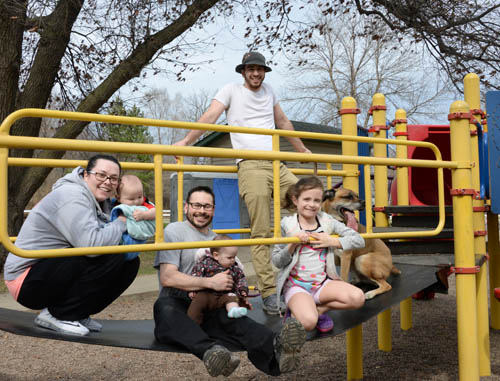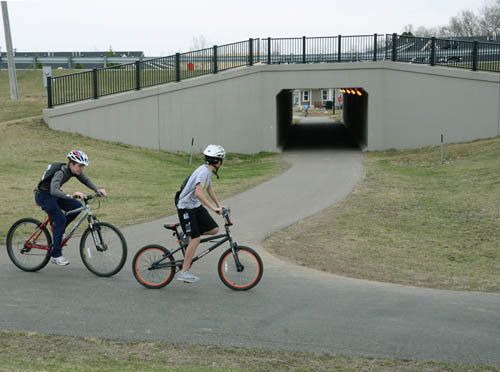Set in the rolling landscape of north-central Dakota County, Rosemount was originally established as a township in 1858, the same day Minnesota became a state.
 A few years later, settlers founded the original village of Rosemount, and later the village and township merged. In 1974, the community became the city of Rosemount.
A few years later, settlers founded the original village of Rosemount, and later the village and township merged. In 1974, the community became the city of Rosemount.
A large number of early settlers immigrated from Ireland, and the Rosemount area phonebook is filled with Irish names. Named for a village in Ireland, the city features a shamrock on the municipal flag, and the high school teams are nicknamed the “Irish.”
Rosemount, it turns out, is a land of green in other ways. On a map, you’ll see one area of green after another, large and small, representing community and neighborhood parks in the western third of the city, where most residents live.
ROSEMOUNT COMMUNITY PROFILE
Location – North central Dakota County
Population - 23,042*
Households - 8,095*
Jobs - 8,528*
Top 5 Employers – Rosemount School Dist. 196, Flint Hills Resources, Wayne Transports, Dakota Cty. Tech. College, Intermediate School Dist. 917
Notable feature – Extensive park system, University of Minnesota’s UMore Park
Regional Parks – Spring Lake Regional Park and nearby Lebanon Hills and White Tail Woods Regional Parks
Major highways - North/south: Hwys. 3, 52 & 55 East/west: Co. Rds. 42 & 46
Transit - Express service to Minneapolis and Saint Paul downtowns provided by Minnesota Valley Transit Authority
*Metropolitan Council 2015 estimates
City focuses on recreation, green space
The city boasts 30 parks, totaling 540 acres, featuring soccer fields, tennis courts, nature areas, and playing fields for Little League baseball, softball, lacrosse, and youth athletic activities. Walking trails and natural areas are part of the mix. An open-air amphitheater seats 2,500, and five parks host community garden plots, awarded by lottery.
“Demographically, our household size is bigger than average, with relatively more families with children. As a result, parks and athletic fields have a very high priority,” said Kim Lindquist, city community development director. “In turn, our parks and open space help make our community attractive to families with children.”
The active lifestyle reflected in the city’s park and recreation investments is evident in other decisions of the city—for example, in Rosemount’s 2009 comprehensive plan, which includes a section on active living. “Since that time, the city has incorporated these themes in our routine process of making decisions,” said Lindquist. “Our city is mostly residential, so we’re always assessing projects and proposals for connections to parks and services without having to use a car.”
Ped/bike master plan creates connections for residents
One such effort is translating the city’s Pedestrian and Bicycle Master Plan into reality on local streets. For example, the city has redesigned one of its parkways to calm traffic and accommodate bike lanes. The city “slimmed down” the road by reducing the number of traffic lanes, adding a center median. It posted reflective pedestrian crossing signs to make it safer for pedestrians to cross where there are no stop signs or traffic lights.
 Even as a city of parks, Rosemount is framed by parks and natural areas. These include three Dakota County Regional Parks—Lebanon Hills Regional Park just across the city line in Eagan, Whitetail Woods to the south in Empire Township, and Spring Lake Regional Park, atop the bluff overlooking the Mississippi River.
Even as a city of parks, Rosemount is framed by parks and natural areas. These include three Dakota County Regional Parks—Lebanon Hills Regional Park just across the city line in Eagan, Whitetail Woods to the south in Empire Township, and Spring Lake Regional Park, atop the bluff overlooking the Mississippi River.
“Our good working relationship with Dakota County helps us coordinate our plans with theirs,” said Lindquist, “such as improving connections for residents to enjoy these great resources.”
The Spring Lake Wildlife Management Area, under the jurisdiction of the State Department of Natural Resources, lies on the edge of the Mississippi River. Just upriver is the Pine Bend Bluffs Scientific and Natural Area.
Rosemount has room to grow
Developing from rural and agricultural roots, Rosemount has seen significant growth over the decades. Its population of 4,000 in 1970 grew by 26% during the decade, and then 70% in both the 1980s and 1990s. Between 2000 and 2010, its population grew by half again as much. The Metropolitan Council forecasts the city to have 38,000 residents by 2040.
 The city has room to grow. Rosemount has wide expanses of open land, with 65% of acreage inside city boundaries either undeveloped or agricultural. A large share is owned by the University of Minnesota’s UMore Park, occupying about 4,800 acres in the middle third of the city and parts of Empire Township to the south. The land was originally taken by the federal government in 1942 for production of gun powder during World War II.
The city has room to grow. Rosemount has wide expanses of open land, with 65% of acreage inside city boundaries either undeveloped or agricultural. A large share is owned by the University of Minnesota’s UMore Park, occupying about 4,800 acres in the middle third of the city and parts of Empire Township to the south. The land was originally taken by the federal government in 1942 for production of gun powder during World War II.
The U of M has declared its intention to open up parts of UMore Park to private development. An expected light-industrial and business park would occupy the far northeast corner of UMore Park, with potential residential development near Dakota County Technical College.
“If you imagine dividing the city into thirds, west to east, the western part is almost fully developed,” said Lindquist. “We expect growth to move into the middle third in the next few years, and the eastern third, on the other side of Hwy. 52, has growth potential in the decades to come.”
City has started local comprehensive plan update
Looking to the future, the city has taken steps to update its comprehensive plan to the year 2040. It held a community-wide kick-off event, and has identified neighborhoods that may be affected by the plan update—the historic downtown, the north-central rural area, and the southeast portion of the city. For the three neighborhoods, the city has held small group meetings that will continue throughout the planning process.
The city is also using its website to provide information about the plan update and exploring nontraditional public engagement activities.
A local comprehensive plan lays out a community’s vision for the next 30 years, what it plans to do, and how and when it plans to do it – things like road improvements, local sewer extensions, new parks. Communities are required under state law to update their comprehensive plans every 10 years. The Metropolitan Council reviews those plans for consistency with regional plans for transportation, water resources, and regional parks. The next round of local plan updates are due to the Council by Dec. 31, 2018.
More information
More about Rosemount on the Council’s Community Profiles website.